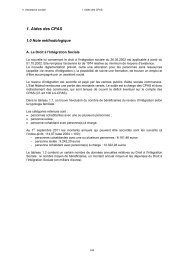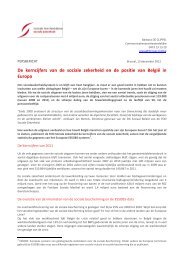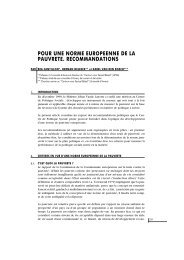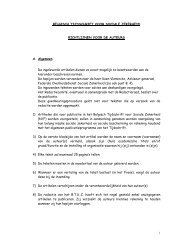social security - FOD Sociale Zekerheid
social security - FOD Sociale Zekerheid
social security - FOD Sociale Zekerheid
- No tags were found...
You also want an ePaper? Increase the reach of your titles
YUMPU automatically turns print PDFs into web optimized ePapers that Google loves.
Workers in the private sector and artists who are not self-employed can obtain lots of information,such as their personal details, a simulation (amount, duration, date of payment), paid amountsand, in certain cases, deductions for creditors, via the secured application "My vacation account"(on the website of the National Office for Annual Vacation). It is also possible to enter or changecertain data (language, financial account number, other address than the official correspondenceaddress).B. (White-collar) employees (and apprentice employees)The vacation fee for (white-collar) employees is paid by the employer. There is no interventionof a <strong>social</strong> <strong>security</strong> institution.(White-collar) employees are entitled to 2 vacation days per complete worked month in theactivity year before the year during which the vacation is taken (= holiday year). That correspondsto 24 vacation days (six-days-a-week scheme) and 20 vacation days (five-days-a-week scheme)for a complete year in service or of assimilated periods, or a maximum of 4 complete weeks ofpaid leave in the scheme of an employee working during his vacation. Just like for (blue-collar)workers, the vacation fee for (white-collar) employees consists of a simple vacation fee and adouble vacation fee. In fact, the simple vacation fee is a continued payment of the monthly salaryduring the vacation period. In addition, they receive a supplement on top of their gross monthlysalary at the moment of their main vacation: this is called the "double vacation fee", which coversextra holiday expenses. The double vacation fee corresponds to a supplement of gross monthlysalary, and amounts to 12/12ths of 92% of gross salary of the month in which the vacation istaken. If you have not worked a complete year, the double vacation fee is reduced proportionally.Moreover, in certain situations (at end of the employment contract or in case of career interruptionor time credit), the employer pays the employee, at his departure, a departure vacation fee thatequals 15.34% of the gross salary the employee earned with him during the current activity year,in certain cases increased with a fictive salary for the days of inactivity that are assimilated todays of normal actual activity.Moreover, when the employee or apprentice employee has not yet taken his vacation to which hewas entitled the previous year, the employer pays him 15.34% of the gross salary the employeeearned with him during that activity year, in certain cases increased with a fictive salary for thedays of inactivity that are assimilated to days of normal actual activity. The employer has to drawup the vacation certificate(s) and hand these to the employee.When an employer concludes a new employment contract with an employee that works with himand the result of this new employment contract is a lower number of working hours per week,the employer pays him a departure vacation fee according to the above-mentioned provisions atthe same time as he pays the salary for December of the year during which this change in weeklyworking hours took place. However, the fixed end-of-year premiums are not taken into accountfor this, i.e. the premiums that are not granted on the basis of an evaluation of the performanceof the employee, his productivity, the result of the company or a department or on the basis ofany criterion that makes the payment of the premium uncertain and variable.61
















